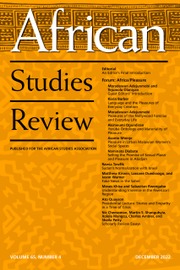Part of review forum on “Green Lands for White Men: Desert Dystopias and the Environmental Origins of Apartheid”
Green Lands for White Men tells a familiar story of twentieth-century African history with a twist. In this narrative, a European minority in Africa diminishes the local knowledge of its peripheral subjects. But the undermined subjects of this book are settlers themselves. The diminished ideas center on rainmaking, false prophets, and doomed ideas to engineer the environment. The book focuses on a failed scheme to redirect southern Africa’s great rivers to flood the denuded plains of the Kalahari. If white farmers in the region’s interior had access to regular water, the prosperity of settler agriculture could be secured for generations to come.
McKittrick succeeds in foregrounding an idea long neglected in the literature of African environmental history: the relationship between environmental change and racial identity. The historiography on apartheid in South Africa has often emphasized urban white demands for segregation, but McKittrick shows how rural demands for state support were equally influential in forming a kind of white environmental nationalism. For these farmers, drought was more than a material threat. Mastery over the environment was central to white settler identity. Environmental insecurity threatened to undermine the edifice of settler rule. For farmers to slip into indigency was a failure of both environmental and ideological proportions.
Settler identity was in large part based on a mythology of conquest and endurance. The familiar aspects of this mythology center on histories of military might and economic prosperity, but McKittrick successfully argues that the environment was equally fundamental to settler mythology. That these farmers had survived and prospered in the harshest of dry conditions was testament to their self-proclaimed right to settle. Like all collective myths, such narratives elided the significance of annexing prime agricultural land from African clans and the centrality of coerced labor in agricultural productivity. But the immense transformations in late-nineteenth and early-twentieth century southern Africa threatened to undermine the sanctity of environmental dominance.
The twinned revolutions of industrialization and settler expansion changed the course of the region’s history. Ernest Schwartz, the protagonist of the Kalahari Redemption Project, emerges from the confluence of this process. The most popular and dynamic of the boosters of environmental transformation, Schwartz was far from a lone voice. Instead, he lent scientific credibility to folk histories of arid environments and catalyzed a populist movement among white farmers.
The Kalahari Redemption Project captured white farmers’ attention more for its promises of collective settler prosperity than its technological sophistication. Schwartz’s scheme promised to connect the Chobe and Kunene rivers, yet it was derisively referred to by his critics as little more than a beaver dam. For his supporters, the details of the scheme mattered less than its transformative potential. Overcoming the environmental constraints of the region’s interior represented the settlers’ final frontier.
McKittrick mines the written records of Schwartz, his scientific contemporaries, and the rich passages of debate in agricultural periodicals. Black South Africans were remarkably absent in these pages, both as participants in the debate and as inhabitants of the lands affected by settlers’ environmental ambitions. Perhaps one area where the argument may have been extended is by turning to the legacy of rainmaking in the region. Rain had been a perennial concern for southern Africans long before settler incursion, yet rituals of rainmaking had been stamped out by generations of missionary and colonial pressure. Schwartz was a man of science, yet his promises of environmental healing were not dissimilar to earlier rainmakers. What might African elites have made of these modern white rainmakers?
Green Lands for White Men is interested less in the specifics of why Schwartz’s scheme faltered than in the dreams of the Edenic environment that it conjured. Through the failed schemes of the past, we learn something of the ambitions and constraints of earlier generations. White farmers saw reengineering the environment as a means to stave off the pressures of drought, an industrializing economy, and the precarity of being a settler minority. By tracing the intellectual lineages of Schwartz and his supporters, McKittrick presents a compelling environmental history of southern Africa, settler society, and the close association between identity formation and landscape.

